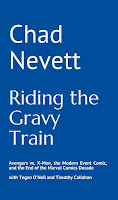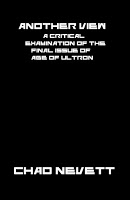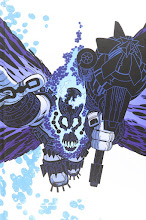I am buying far too many comics. Far, far too many. It's never a slow week anymore. But, whatever, because I got some good comics. Let's get to discussing them.
The Boys #19It took 19 issues, but Garth Ennis has finally brought war stories to
The Boys. Let us all take a moment to reflect on that. Okay. Someday, someone with more brains than I possess will do an excellent overview of Ennis's career, looking at his pet themes that crop up so obviously in everything he writes. And there's nothing wrong with that. Most great writers constantly explore the same ideas over and over again from different points of view in an effort to better understand it. I really enjoy watching Ennis do that, because he writes some damn entertaining comics. This issue is divided between Hughie getting a history lesson from the Legend, and the Seven meeting with the Boys (plus a bit on Lamplighter covered in his own shit). I did enjoy the moment where the Seven's "Aquaman," the Deep comes out of the water and the Frenchman sees this and begins laughing at how fucking stupid he looks. Because he looks really, really stupid. Yeah, this book is full of cheap shots against the superhero genre, but it does have an underpinning of ideas like friendship, loyalty, power, and the general goal of making life decent for most people. Frankly, stuff like that reads better with cheap shots and crude jokes--at least, in my opinion.
Cable #4Oh, so that guy at the end of last issue was Cannonball. Totally didn't get that. Probably should have, what with the giant "C" on his chest. My favourite bit of this issue were the three panels depicting his aging as the "C" changes shapes and sizes. Costume evolution, people. There's also a fuck-up in this issue where Cannonball calls Bishop "Nathan"--or, it was a Freudian slip. I would love to see Swierczynski see the mistake and then make it a Freudian slip, because that's much more interesting. Kind of a meh issue that would have been better had Cable not just reversed his entire position on the last page for no real reason. This book still lives on the edge of "Not buying another goddamn issue." The last book that lived there and didn't make it back was
Midnighter, which was cancelled soon thereafter. Coincidence?
Criminal #3Speaking of coincidence, the essay for this issue discusses a Sydney Pollack film a couple of weeks after he died. Weird.
This comic is depressing and sad, but real fucking good. It gives us the story of Danica and doesn't even cover the heist that winds up killing her. A little curveball from Brubaker as we all expected at least some of that story since it's the connecting event of the first three issues--but, no, we get none of that. Why? Because this gives us all we need. We get the background and Danica's role in the heist is pretty easy to figure out. It was explained in the first two issues a bit, but Brubaker also relies on the reader to fill in anything else. An easy job considering the fantastic work here.
Duostar Racers #1...what the fuck? No, seriously, what the fuck? Normally, I defend Ashley Wood's work, but this...
what the fucking fuck is this shit? I didn't understand a goddamn thing in this comic and I'm sure that's my fault somehow, or Wood's art has become so obtuse and flat-out impossible to understand that it actually makes no sense. I miss
Lore. That was a fucking good comic. Maybe I'm missing stuff, but is Wood just jumping from half-finished project to half-finished project these days mostly? If I see issue two on the shelves (which, knowing Wood, who knows), I'll probably pass.
Holy War #2Again, I refuse to recognise the full title as the rest of the fucking title is retarded. I'm sorry, but "Holy War" is a million times better than "Rann-Thanagar Holy War." It's true, Dan Didio. It's true.
This is one fucked up comic as our beloved heroes continue to try and build an anti-religion ray--seriously, they're letting Jim Starlin do a comic like this? His last book had him killing gods and now, the main thrust of this book is about how religion fucks everything up for everyone. I love this man. Oh, and then a dinosaur shows up. EVERYONE FIGHT THE DINOSAUR! WHOO!
Ron Lim's art continues to underwhelm me. It's still decent, just not as good as I've seen elsewhere. But, it's also a 30-page comic, which is nice. At first, I thought it was just Starlin's style of storytelling that seemed to take longer (okay, it still does), but then I counted: 30 pages. Awesome.
This comic isn't that great, but I enjoy it as a fan of Starlin. Some may find other reasons to like it, but Starlin doing a comic about building an anti-god ray is enough for me.
Infinity, Inc. #10This book ends with issue twelve, sadly. This comic is one of the weirder ones on the shelves and never really found that right balance. Personally, I've really liked Millgan's off-kilter approach that pays the most superficial of tributes to the genre conventions while throwing as much fucked up shit as possible at the reader. But, come on, did anyone think a comic from DC about how superpowers fuck you up would sell well? Really? Even Pete Woods couldn't save this title from the axe.
In this issue, the team fights against small town cops and hicks--who are working with an evil doctor that hurts people with a pen.
And people are surprised this isn't selling to the hardcore fanboy crowd? Really?Damn, I really like this book. On the plus side, I'm accumulating a nice collection of books that lasted a year or less that I can devote some nice long posts to. Guess
Infinity, Inc. goes in that pile now.
The Invincible Iron Man #2Matt Fraction is totally in love with Thor. At first, he didn't like Thor, but, now, he has a huge man-crush on Thor--and who can blame him? Take a look at that blonde hunk of man-meat and tell me you could resist his charms? Oh, sure, first it was just a "one-shot" and then Fraction planned to never see him again, but that "one-shot" soon became a couple more and then a three-issue mini-series tying into "Secret Invasion." Now, Thor is showing up in Fraction's brand-new Iron Man title and totally rocking our collective worlds. I wouldn't be surprised if he shows up at the end of the current
Punisher War Journal arc, taking down Jigsaw--and then, when
Casanova returns, a suitable substitute is introduced there. Maybe an appearance at Danny's birthday part in the next
Iron Fist? Or a quick trip to SF to team-up with the X-Men in
Uncanny? Fraction has got the Thor love disease and there's no cure.
Nor would anyone want one.Omega the Unknown #9The Mink fights his giant hand to the death.
This comic just blew my mind.Secret Invasion #3Okay, can the Young Avengers actually do shit in a fight? I've seen these young losers exactly twice: now and during Civil War where they got their asses handed to them by Noh-Varr. Or, are they just utterly helpless against aliens? Really, shouldn't someone have stopped these kids from pretending to be superheroes until they were properly trained in
not getting their asses handed to them all of the time? These guys are shit. I'm glad they're dead, because at least they served the goal of filling up a big chunk of this issue and making Nick Fury seem even more hardcore. See, that's him on the last page with another bunch of young superpowered people who he
actually trained to kick ass, not just die in the middle of Manhattan like a bunch of losers. The lesson: the world needs Nick Fury to train superpeople. Or, is it? We haven't actually seen the new Howlin' Commandos in action, but guess what? They have a little Greek god that's going to make the entire Young Avengers squad want to vomit at the thought of costuming up again, because if a seven-year-old can fuck Skrulls up better than the entire team put together... christ, those Young Avengers suck. Hell, the Initiative sucks, too. They show up and the Skrulls kind of shrug and then
begin executing heroes in the street while saying "He loves you" in their weird Skrull language.Oh, and Tony Stark may be a Skrull. At least, that's what the Skrull queen says. And we should trust her. She hasn't been lying about stuff since forever, right? Right?
It may not be apparent, but I enjoyed this comic. Even notice how these posts degrade over time--with initial reviews having a point and maybe some logic... and then later ones has you wondering what the fuck have I been drinking/snorting/popping/injecting to come up with these insanely retarded "reviews"? The answer, dear reader, is nothing. Nothing.
Trinity #1I'm not buying another issue. This wasn't bad, it just wasn't good. I couldn't even read the back-up story all of the way through, because of the inane dialogue. Oh, and the "Trinity" discuss their dreams over waffles or pancakes, whatever's easier. Great. Really, I'll admit, I went into this issue thinking the whole "these three heroes are somehow linked and important" idea is kind of stupid--I left it thinking the whole "these three heroes are somehow linked and important" idea is really stupid, because what's linking them together? SCARY DREAM THAT DOESN'T FEEL LIKE ANY ORDINARY SCARY DREAM! Nothing here that makes me want to learn more. I just don't care.
"But, Chad! Chad, you can't just judge this comic based on one issue! That's not the way things are done these days!"
No. I'll give books the benefit of the doubt when there's something that has me--this book had nothing. Good for you if you liked it, I'm happy for you, really I am, but I'm out. I don't need to buy a book I don't like four times more a month than normal. That's just stupid.
Hellblazer: Rake at the Gates of HellGarth Ennis ends a run like no one else. I've read a lot of his stuff, but only two major runs completely: this and
Preacher. In both, he somehow brings it all together in ways you don't expect but seem completely obvious at the same time. He does have a habit of getting into "greatest hits" storytelling in many ways, but he makes it work. The conclusion to his run on
Hellblazer is nearly perfect in the way he ties the entire thing together, dovetails John's story with another, somehow has John come out on top, but not without paying a heavy price and feeling like a complete ass as a result. Ennis knows how to play with a reader's connection to these characters better than any other writer in comics. No other writer has even made me laugh so hard or feel so shitty. While I'm enjoying
The Boys quite a bit, I know a part of me is reading the book just for that final arc, because Ennis will fucking bring it. He always seems to. This is a very, very good trade and should only be gotten if you have the rest of his run on the book. I'm sure it would read alright without knowing what came before, but why chance it?













